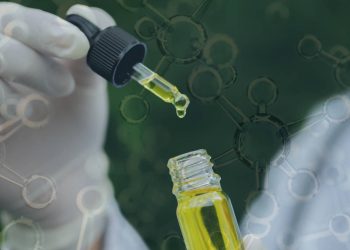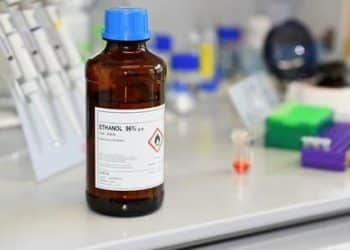Kannalife’s Douglas Brenneman, PhD, discusses his team’s discovery of a novel compound that may overcome the pharmacological shortcomings of CBD
Cannabidiol (CBD), the current “darling” of the cannabinoid family, has a big problem – its multitude of mechanisms of action. CBD affects several systems in the body by binding to a host of receptors beyond cannabinoid (CB) 1 and 2. In fact, CBD interacts with GPR55, TRPV1 and 5-HT1A receptors, among others, many of which are currently under study. These widespread mechanisms of action explain how CBD can be effective for pain, inflammation, anxiety, and even psychosis. [1]
This comprehensive range of effects may seem beneficial to patients, as taking just one dose of CBD could potentially ameliorate a host of symptoms. But, for researchers and drug companies trying to advance the development of a CBD formulation to be used by one specific patient population for one condition, this poses a significant barrier. Luckily, scientists at Kannalife, Inc., a phyto-medical company, are making strides to overcome this challenge.
Kannalife is developing cannabinoid-based therapeutics designed to treat and prevent neurological conditions caused by oxidative and neurotoxic stress, and have patented a CBD-derived neuroprotective agent, KLS-13019, to treat hepatic encephalopathy. We spoke to Douglas Brenneman, PhD, co-inventor of Kannalife’s recent patent, whose team discovered KLS-13019.
Dr. Brenneman is a neuropharmacologist who never imagined that his research would take him into the cannabis sector. His entire career has focused on developmental neurobiology and how to protect the nervous system from damage, what he calls a “very formidable task.” Brenneman works with primary neural cultures, simulating drug delivery to cells in the brain, to better understand how different drugs affect the physiological and molecular processing within and between cells.
While Brenneman spent many years working at the National Institute of Health, he also gained invaluable experience in industry science as a team leader at Johnson & Johnson. Thus, his integrated academic and industry training prepared him for a transition to entrepreneurial CBD science when he joined Kannalife.
Sara Jane Ward, PhD, Assistant Professor of Pharmacology at Temple University, a colleague of Brenneman’s, first introduced him to CBD science. Dr. Ward is particularly interested in the effect of cannabinoids on neuropathic pain. The two began collaborating and still work together today – but it took some convincing to first get Brenneman on board. Brenneman described his initial interactions with CBD as follows: “It worked…[but]…I was very unimpressed with its potency.”
As a pharmacologist who has spent considerable time trying to develop “druggable” compounds, Brenneman was frustrated at the high doses of CBD required to produce an effect. And he was not happy that CBD has a “bewildering number of pharmacological actions.”
To move a compound from the discovery phase into clinical trials, it must have a “clean” and specific mechanism of action, a low-to-mid-range dose, and an acceptable safety profile. If pharmacologists are not certain of these properties, it is likely that the compound will fail clinical trials and thus be “killed” (removed from the pipeline) so that it doesn’t advance into human testing.
“Big Pharma would never move [CBD] forward because it’s really a dirty…compound…
and that’s where Kannalife came in,” said Brenneman. “They wanted…our team to address the shortcomings of CBD, and to try to modify its structure in hopes of getting something a little cleaner, a little more directed.”
And, so, with a team of experts in tow, Brenneman began to work toward a “cleaner” CBD that could be used to treat hepatic encephalopathy, a rare disorder that causes a range of neurological conditions that develops in some people with liver disease. This search led to the discovery of KLS-13019, a novel small molecule created by adding heteratoms on the pentyl groups of CBD. This chemical structure change aimed to increase solubility. [2]
Careful analysis of this compound revealed that it is 50-fold more potent and >400-fold safer than CBD. In addition, KLS-13019 has improved oral bioavailability, the amount of active drug that enters the blood system and can therefore take effect. [2] In a more recently published study, Brenneman and his team found that, compared to CBD, KLS-13019 is 31-fold more potent in preventing damage to neurons caused by toxins, and that KLS-13019 is safer than CBD (5-fold less toxic). [3] Taken together, these studies indicate that KLS-13019 may be an effective alternate to CBD.
These results may be slightly confusing for many, as CBD is marketed as a very safe compound. Not always, said Brenneman.
Across his many years of research, Brenneman has found that CBD, at certain concentrations, actually can cause neurotoxicity. This is certainly alarming to hear, especially since the FDA recently approved a CBD-based therapy, Epidiolex™, to treat severe forms of pediatric epilepsy. While clinical trials demonstrated that this product is both effective and safe, Brenneman is concerned with its long-term effects on cognition.
“We know that the [developing nervous system] has different vulnerabilities than the mature system,” said Brenneman. “Detailed studies [should be] done on learning and memory in children and in adults…the ‘all-clear’ [on CBD] is not there yet.”
It’s important to take his concerns into consideration when deciding to use CBD medicinally; however, the nervous system is quite complex and the effects of certain compounds on the entire body compared to individual cells are likely quite different.
Still, the science behind CBD certainly does not yet warrant dosing everyday food and drink with the compound without further evaluation of its long-term effects. But one thing is for certain – as the medical cannabis industry continues to expand, companies like Kannalife must continue pursuing research into cannabinoids as they would for any other potential medicine.
Creating cleaner compounds that take a more targeted effect on receptors and systems in the body will advanced cannabis science and move more potential drugs into clinical trial – and gain greater acceptance by following the traditional path toward drug development and approval.
References
- Campos, A.C., Moreira, F.A., Gomes, F.V., Del Bel, E.A., Guimarães, F.S., “Multiple Mechanisms Involved in the Large-spectrum Therapeutic Potential of Cannabidiol in Psychiatric Disorders”, Philos Trans R SocLond B BiolSci, 2012, Volume 367, pg. 3364-3378. (impact factor: 5.57; cited by: 198)
- Kinney, W.A., McDonnell, M.E., Zhong, H.M., et al., “Discovery of KLS-13019, a Cannabidiol-Derived Neuroprotective Agent, with Improved Potency, Safety, and Permeability”, ACS Med Chem Lett, 2016, Volume 7, pg. 424-428. (impact factor: 3.794; cited by: 6)
- Brenneman, D.E., Petkanas, D., Kinney, W.A., “Pharmacological Comparisons Between Cannabidiol and KLS-13019”, J MolNeurosci, 2018, Volume 66, pg. 121-134. (impact factor: 2.891; cited by: N/A)












